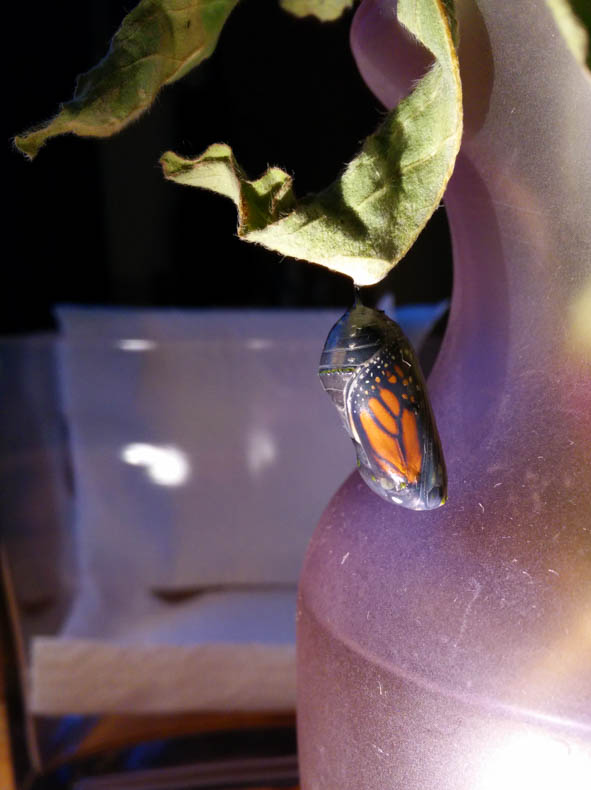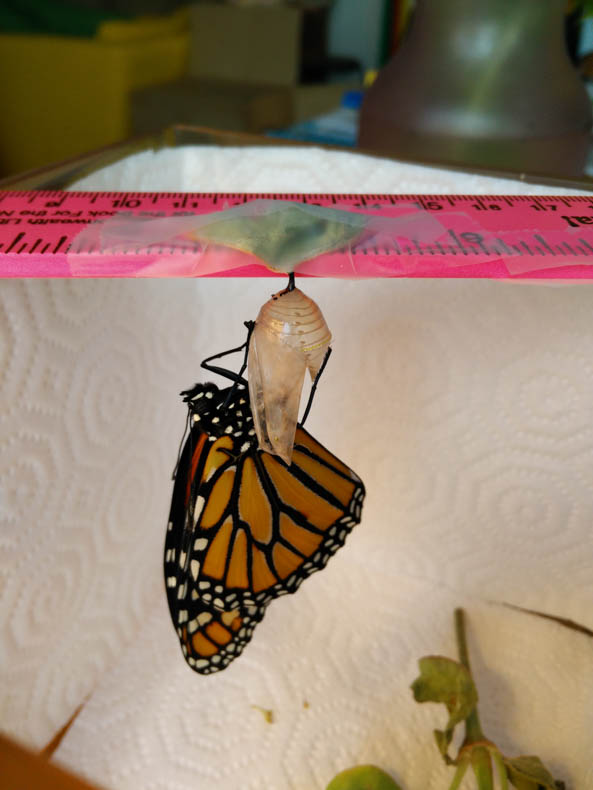 Two weeks ago, my living room was home to a miraculous transformation.
Two weeks ago, my living room was home to a miraculous transformation.
In truth, this transformation was utterly mundane: An insect entered the last stage of its development. It just happened to do it on my dining room table. And it was beautiful.
On a Sunday afternoon in August, I brought home a cheerful bouquet from the farmers market.
The next morning I was eating my granola, feeling happy about bringing this bit of the outdoors into my apartment, when something green caught my eye. Light green. Lighter than the foliage, dangling from a drying leaf, dotted with gold. I realized I was looking at some kind of lepidopteran, a moth or a butterfly, in its pupa.
My first impulse was to get rid of it. I didn’t want some terrifying moth-monster to bust out of its developmental jail and go flitting around my apartment.
But before I put it in a bush outside to fend for itself, I put a picture on Facebook and got a verdict from knowledgeable friends: Monarch.
So it wasn’t just any pupa–it was a chrysalis (the butterfly word for “pupa”) of one of North America’s best-loved bugs. And it’s not just that you’ve heard of them. You probably know at least one of these facts: They eat milkweed; they migrate; they’re orange and black.
I’m like anybody else—susceptible to fame and beauty. So I read up, learned that I would have advance warning of its emergence, and decided the monarch could stay.
Lepidopterans have multiple ways of pupating. Some moths spin a cocoon, winding themselves up in silk and transforming inside it. Silkworms, one of the few insects that humans have domesticated, are the larva of a pretty gray moth, Bombyx mori. When they pupate, they spin the silk we turn into cloth.
Monarchs don’t spin silk. Toward the end of the last instar of caterpillarhood—that stage has 5 steps, punctuated by molts—they find a hospitable spot, like a twig or leaf. The caterpillar hangs by its butt, then shrugs off its stripey skin, revealing the green chrysalis inside.
My chrysalis showed the outlines and veins of wings and the stripes of an abdomen. It was decorated with a line of perfect spots, like specks of gold leaf–perfect, a jeweled pendant. It hung silently, but inside it was hard at work, doing whatever it needed to remodel its innards from those of a crawling larva to those of a flitting adult.
I joined a Facebook group for people devoted to raising monarch butterflies at home. I learned all sorts of things–like the earlier life stages, the parasitic flies that can attack, and the jargon for caterpillars: “cats.” I learned that sometimes development just goes wrong; a wing might form incorrectly, for example.
Every morning I checked the pupa. Green. Still green. After four days I started to worry—had it died inside? How would I know? I thinned out the tired bouquet. The vase was down to just a few stems, including the globe amaranth whose dried-out leaf hosted the monarch.
But, finally, it happened.
One afternoon when I came home from work, the wings were darker. The next morning, I leapt out of bed at 6:45 and there it was, 10 days after I brought it home, a perfect orange and black butterfly, crammed into a package smaller than my thumb.
 I set it up over a square glass box, lined with paper towels in case if it lost its grip. I checked every minute or two for a while, then tore myself away for a while. When I looked again, the chrysalis was rocking as the butterfly pushed its head against the side, like someone trying to get out of a trap door with their hands full.
I set it up over a square glass box, lined with paper towels in case if it lost its grip. I checked every minute or two for a while, then tore myself away for a while. When I looked again, the chrysalis was rocking as the butterfly pushed its head against the side, like someone trying to get out of a trap door with their hands full.
The abdomen popped out, then the wings.The antennae sprang free. Within four minutes, the adult was hanging from its old shell, its crumpled wings already growing. It pumped its abdomen, telescoping it in and out. Its face wiggled, the fuzzy appendages that I now know are called labial palps working to adjust its proboscis. By 8 a.m. I had a full-sized butterfly.
It’s awfully tempting, for a writer, to compare a butterfly to oneself. The last year has been a time of great change for me: the end of a relationship, trying out new skills at work, concerted efforts to fix the things in my body that give me pain.
But this butterfly didn’t make it to adulthood so it could be my metaphor. It has its own life, its own timeline, its own future—with luck, one that involves finding its way to Mexico, and maybe helping a nice lady butterfly produce a new generation of Danaus plexippus.
After a few hours clinging to its chrysalis, the butterfly explored its enclosure. It walked onto the ruler I’d taped the pupa to, then the screen on top, then the paper towels. Eventually it started fluttering and I thought it was time to let it go. I took it to the yard of a neighbor with a lot of flowers. The brand-new butterfly flew up to the top of a tree and waved its wings in the sun.
Photos and video: Helen Fields. I actually took a lot of little videos; see the abdomen; the wiggly face; some experimental flapping; and the great outdoors.

I volunteer in a museum that has a huge butterfly enclosure and breeding lab. The chrysalises themselves are often beautiful and watching a butterfly emerge from one is truly amazing. To have it happen on your dining room table is very cool.